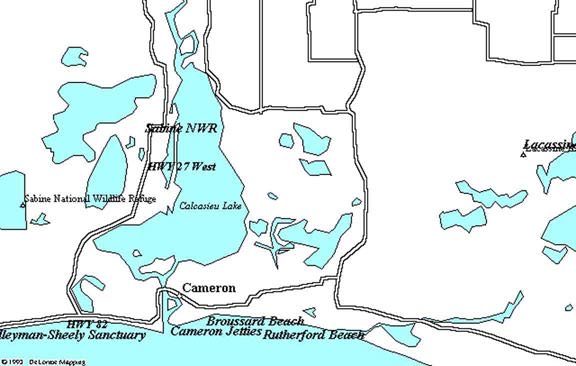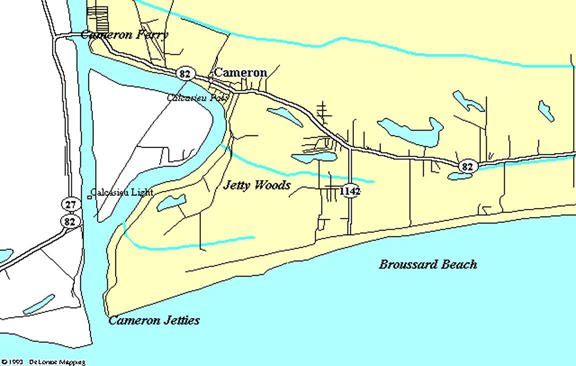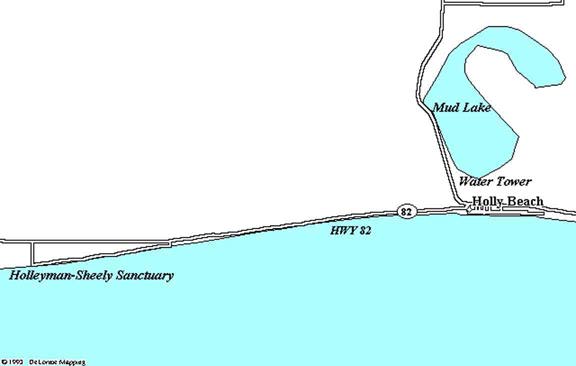Birding in SW Louisiana | Lake Martin | Vincent NWR
Cameron Parish is truly a paradise for birds. Due to its large size and location, it contains a wide array of habitat types, including prairie, gallery woods, hardwood swamps, freshwater and saltwater marshes, cheniers (oak woods on old ridges of the gulf beach), beach, and open gulf. It is also very sparsely populated.
For songbirds and migration, coastal locations such as the Holleyman-Sheely Migratory Bird Sanctuary (owned and maintained by Baton Rouge Audubon Society), and the Jetty Woods (private property) are optimal. For birds of the freshwater marsh, the Sabine NWR boardwalk, the Cameron Prairie NWR, and the Gibbstown Bridge are accessible, birder-friendly stops.
Highway 82 near Holly Beach, the East Jetties at Cameron, and Broussard and Rutherford Beaches are outstanding birding areas for viewing beach and mudflat flocks.
An Overview of Cameron Birding Spots
The best birding spots in Cameron Parish are, arguably, near the coast. Looking at the map below, you should note two important features-Calcasieu Lake and the Calcasieu Ship Channel. These two bodies of water divide the southern half of the parish in such a way that access across the parish in an East-West direction is possible only taking I-10 to the north, or by taking the Cameron Ferry in the south. To go to Holly Beach, for example, one can either take the "Hwy 27 West" exit of I-10 west of Lake Charles and head south, or go to Cameron, Take the ferry, and continue west from there.
On the west side of the channel, Highway 27 West runs from Sulphur to Holly Beach and passes the Sabine NWR, where you can survey marsh life from a boardwalk, Mud Lake, where there are sometimes odd grebes near the pulloffs, and the Holly Beach water tower, where a Peregrine Falcon takes up residence every winter. Here it joins up with Highway 82. Heading west, 82 runs along the Gulf; it offers a great opportunity for scanning the waves, beach, power lines and barbed-wire fences along the Gulf. It also takes you to the Holleyman Sanctuary, and eventually, Texas.
On the east side of the channel, such notable birding areas as the East Jetties, Broussard Beach, and Rutherford Beach can be found.

Overview of Cameron Birding Spots
The Jetties and Nearby Beaches
The Jetties, and Nearby Beaches The town of Cameron is an excellent departure point for birding. The East Jetties are merely a mile south of the town's Main Street, and Broussard Beach and Rutherford Beach are just a few miles to the east. In addition, the ancient oaks of the town provide shelter for migrants and such resident birds as Inca, White-winged and Eurasian Collared Dove, which can often be seen feeding together on streets near the courthouse. To get to the jetties, simply turn south by the "Shell CamMart" station and follow the blacktop road to its terminus. If you have any problems finding the right street, just ask; everyone in town can direct you to the jetties. The rock jetties provide good perches for gulls, terns, egrets, etc., and also create vast mudflats in their lee that are resting and feeding grounds for tens of thousands of birds at low tide. The flats can be hard as concrete, but there are soft spots to look out for. People do sometimes sink up to their waists in sucking mud. For the best view of the flats, park by the barricade at the end of the road and cross the fence to where the marsh starts. Set up your scope, and get to work. A good many rarities have been found here over the years.
Jetty Woods, a great woodland that can be good in migration, is also on this road. Heading back to town from the jetties, turn right after the "Red Man" sign on the right. The road will cut back at an angle, head across a pature then into the woods. This is private property, and the gate is sometimes locked, but birders have always been tolerated when the gate is open. Treat the land with due respect! Hitting Highway 82 in Cameron again, turn right to get to Broussard Beach. On Highway 1142, take a right (south), then a left at the bend. You will be running parallel to the beach heading east at this point. Eventually you will see a sand road cutting off toward the beach through the marsh. Take it, but be careful if the road is wet--there are huge potholes that fill with water. When you get to the beach, you will notice a nice mudflat before you. This is Broussard Beach. It hosts big flocks of gulls, terns, and shorebirds, and is one of the best places in the state to find rare gulls. It is also a major wintering spot for Piping and Snowy Plovers. The dirt road continues to the east along the beach, but isn't always to be trusted. Don't take a risk. You can survey most of the same area from the other direction, via Rutherford Beach. The stretch of beach between Broussard and Rutherford have yielded the major part of the state's 5 record of Arctic Tern (in early June), the state's second record of Mongolian Plover (in fall), and always seems to have at least a few Lesser Black-backed Gulls. Here's how to get there: Head back to Hwy 82 and head east past the juncture where 82 heads north. You want to keep on to the right on the highway, keeping parallel to the coast. After a few miles, you'll see a small, unimpressive sign for Rutherford Beach on the right. Take a right. This road takes you through nice open marsh towards the small community of camps known as Rutherford Beach. When you hit the camps, steer toward the beach. The beach is packed and you can drive it to the west until just past the town, where you'll see a big wooden corral. A small sand road passes through the corral and up onto the grasslands adjacent to the beach. This road goes west all the way back to Broussard Beach. There's great birding along the beach and in the grasslands, especially in winter, when there are an abundance of gulls, etc., on the one hand and sparrows on the other. Sprague's Pipit is regular in small numbers in the winter. They can sometimes be seen feeding near the edge of the grass within a few feet of the abundant Water Pipits on the sand. The corral area can be good for lingering migrants in winter. Be sure to turn around and retrace your path when the road leaves the grasslands as it nears Broussard Beach.
Cameron Prairie NWR and the Gibbstown bridge can be reached by heading north on Hwy 27 east between Rutherford Beach and Cameron. Heading north, you will pass by incredibly great wetlands that you won't be able to bird because there are no pulloffs! If you do care to study these lands, take the "Little Chenier" road to the east and simply use the shoulder to view the marsh. When you get back on 27 heading north, you will approach a gargantuan bridge rising ahead. This is Gibbstown Bridge, and the small road/landing on the right just before the bridge is a good place for scanning the marsh for ducks. When you're done, cross the bridge, and you'll almost immediately hit the Cameron Prairie NWR, where thousands of geese are easily observed in the winter.

The Jetties and Nearby Beaches
Sabine NWR, Holly Beach and Holleyman Sanctuary
The area west of the Cameron Ferry includes such birding hotspots as the Holleyman Migratory Bird Sanctuary, the Sabine NWR boardwalk, and a very nice stretch of beach (for birds, anyway) along Highway 82. Beaches Driving west along highway 82 after crossing the Calcasieu ship channel by ferry in Cameron, you will very quickly find yourself driving just north of the Gulf beach. Unfortunately, until you reach the town of Holly Beach, you won't have a clear look at the water. You will, however, see a line of trees forming to the south. This treeline, or chenier, which runs intermittently from here to the Texas border, is located on ridges which were once the coastline of the Gulf of Mexico. They are outstanding birding spots in migration, the first sight of land for Trans-Gulf migrants in spring, and the southernmost woods that migrants in fall can use as they hug the coastline heading west and south. They are also mostly in private hands, and off-limits to birders. You'll have to wait for the Holleyman Sanctuary a few miles to the west before you can sample the chenier birdlife.
At Holly Beach, be sure to take Highway 82 to follow the beaches. On 82 past Holly Beach, the birder is treated to a wonderful dilemma, i.e., whether to scan the beaches on the left, or the fencelines, telephone wires and prairie to the right. Both can provide large numbers of birds. There is a stretch of a few miles of beach that usually has a few huge flocks of gulls and terns that can be scanned from the wide shoulder on the beach side of the highway. Many of these gulls are Laughing Gulls, augmented in winter by Ring-billed, Herring, and Bonaparte's Gulls, but in migration Franklin's can usually be found in small numbers, and practically every other gull species on the state list has been seen on this stretch at one time or another. Terns include Forster's, Royal, and Caspian year-round, and Black, Least, Sandwich, and Common in summer and migration. Gull-billeds sometimes mix with these flocks, although they are easier to find swooping over the marshes on the other side of the road. Other beach birds include Brown and White Pelicans, and the typical mix of Sanderlings, Ruddy Turnstones, Western Sandpipers and Willets, as well as the less common but usually present Snowy, Piping, and Wilson's Plovers.
Scanning the waves in winter can sometimes produce Gannet, sometimes in large numbers, and the occasional jaeger chasing the gulls which follow the shrimp trawlers. Holleyman Sanctuary can be found a few miles to the west of where Hwy 82 again is split from the beach by cheniers. Look for the sign pointing to the sanctuary just across the highway from the monstrous Stingray Compression Plant. Signs will lead you to a parking lot, and the sanctuary is well-marked. Think of Holleyman Sanctuary as High Island without the high volume of birders. Many days of the year it is deserted except for birds. It is the best-kept secret on the Gulf Coast, a tremendous site during spring fallouts and a steady, sometimes spectacular spot in fall. Rainy days in the spring can yield trees swarming with migrants, a veritable sensory overload. Spring migration lasts from mid-March through mid-May, with the peak, in terms of numbers, coming in mid- late-April. If you hit it on a good day, you will never forget it.
West of Holleyman, there are a few beach access roads and good birding, but for the most part, you would need a local birder's assistance to steer you. Sabine NWRis located north of Holly Beach on Hwy 27. Hwy 27 splits from Hwy 82 just west of Holly Beach. Soon after the split, there is a water tower which hosts a Peregrine Falcon almost every winter. Continue north until you see the signs for the refuge (ca. 5-10 miles). There is a large parking area, and a sidewalk which extends into the marsh and to an observation tower. This is a freshwater marsh, with a good variety of waders, rails, shorebirds and waterfowl, and usually a few surprises. Neotropic Cormorant, a Gulf Coast specialty, is an abundant year-round resident, and a few Glossy Ibis can usually be found mixed in with the White-faced. The birds at the boardwalk usually allow close approach.

Sabine NWR, Holly Beach and Holleyman Sanctuary Map